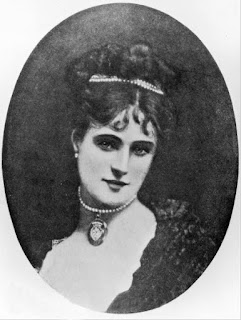[Henry Edwin Landseer, The Shew Tamed - Wikipedia - Public Domain]
We see an elegant Amazon reclining in the hay between the hooves of a glossy steed, while leaning on the horse's shoulder. At first sight, this painting looks like all the other, almost countless animal paintings (particularly dogs) made by Landseer - only suitable for Victorian biscuit or shortbread tins. But in fact, this painting contains several hidden, controversial elements, which deserve our attention.
- The painting was exhibited at the Royal Academy Exhibition of 1861 and in the catalogue was described as a portrait of a noted equestrienne, Ann Gilbert. Ostensibly she reclines on her horse practicing the "taming technique" of a famous "horse whisperer," an American called John Solomon Rarey. Rarey had visited England in 1858 and demonstrated his "horse whisperer" technique to the Royal Family, causing some sensation. Ann Gilbert also advertised her services as a professional horsebreaker.
- But at the time of the exhibition, critics advanced the opinion that the woman in the painting was none other than Catherine Walters, a gorgeous belle from Liverpool who was the top expensive courtesan of her day, also called the "Queen of mid-Victorian harlotry." Catherine Walters (1839-1920), also known as "Skittles," was rumoured to have political leaders, aristocrats and even a member of the Royal Family as her "benefactors." The Prime Minister, Gladstone (whose affairs with courtesans were notorious), marvelled at the narrowness of her waist and was said to have tested it "by manual measurement."
- Walters' classical beauty was matched by her skills as a horsewoman, for which she was almost equally renowned - in the 1860s the sight of Walters and other courtesans riding on Rotten Row in Hyde Park drew large crowds of sightseers. As a blatant advertisement for their trade, these elegant equestriennes brought London to a full stop and fashionable young bucks eagerly courted them, leading to complaints in the press that "eligible daughters of respectable families were without prospect of marriage." But aristocratic ladies themselves copied the cut of Walters' stunning, tight-fitting riding habit (so tight-fitting that the husbands speculated she had nothing on underneath it), making her a fashion trendsetter. Walters was also perfectly discreet and loyal to her lovers, never divulging names or confirming rumors. She died as a wealthy woman. So the name for the painting, "The Pretty Horsebreaker," can very well point at Catherine Walters.
- This is supported by the way the subject has been addressed in the painting: a langerous woman dominating a powerful animal - like a top-class courtesan "dominating" and "taming" the most powerful men of the age. The smile on her face seems to be one of female supremacy as she playfully pats the jaw of the horse with the back of her small hand. One more symbolical step - but I doubt of Landseer meant that - is to read "husbands" for "horses" and see the painting as a small gender rebellion.
- A double identification of the Amazon in the painting is of course also possible: "officially" it is a painting of horsebreaker Ann Gilbert, but "in reality" it refers to the much more famous Catherine Walters, the "breaker of mighty males." (P.S. "The Shrew" in the alternative title refers of course to the horse, not to the woman - this no Shakespeare!).
- You may know Landseer's work without realizing it: he was also responsible for the four bronze lions lying at the base of Nelson's Column in Trafalgar Square.
[Presumably Catherine Walters (or someone like her) on horseback,
with notably narrow waist and close-fitting riding habit. Photo around 1860 - Wikipedia - Public Domain]
[Catherine Walters (1839-1920) - Victorian courtesan - Wikipedia - Public Domain]
Paintings and their stories:
The Birth of Venus by Botticelli
The Nightmare by Fuseli
Suzanna and the Elders by Gentileschi
Jupiter and Io by Coreggio
The Pretty Horsebreaker by Landseer
Girl in a white kimono by Breitner
Lady Godiva by Collier
The Roses of Heliogabalus by Alma-Tadema
Saint George and the Dragon by Uccello
Proserpine by Rosetti
The Lady of Shalott by Waterhouse
Judith and Holofernes by Klimt
Nana by Manet
Symphony in White, No. 2, by Whistler


